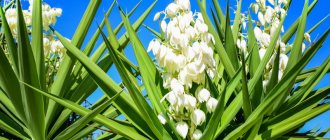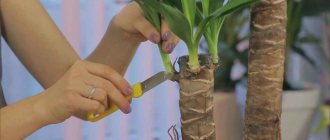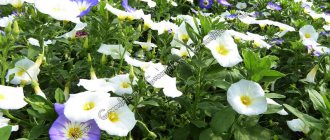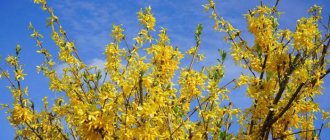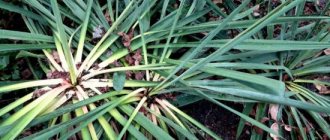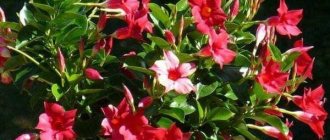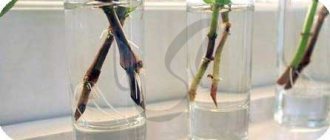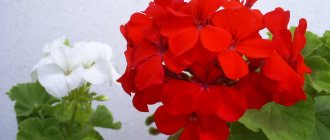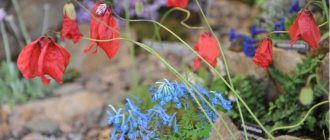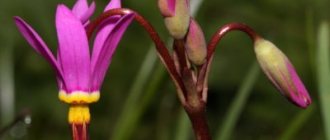Description and photo
Garden filamentous yucca feels great in the northern regions. Here she spends the winter without shelter. Still, the edges of its leaves often freeze. The culture begins to wake up in mid-April. Young greenery appears in the central part of the bush. Over time, the side foliage will turn yellow and die. It is removed to preserve decorativeness.
- The length of the leaves is from 25 to 100 cm, the width rarely exceeds 8 cm.
- In the center of the leaf rosette a very long (1–3 m) peduncle grows, on which bell-shaped flowers appear.
- The flowers are white or cream in color, up to 6 cm in diameter.
- Flowering lasts 2-3 weeks, at the end of June or beginning of July.
- The fruits are medium-sized (5 cm in diameter), round dry seed boxes in which many small seeds ripen.
Yucca filamentosa is an evergreen plant with a dense rosette of leaves. The average size of sword-shaped leaf blades is about 60 cm, their diameter is from 3 to 6 cm. Long filamentous fibers hang from the edges of the tough foliage.
The culture is a garden evergreen plant with flowers resembling bells and thread-like shoots, from which this variety of yucca gets its name. Another name for the culture is filamentosis.
How it blooms
White yucca flowers with a yellow-cream or golden hue resemble bells and appear for the first time in the 2-3rd year of the plant’s life.
A flower panicle grows from the central part of a leaf rosette, usually at the beginning of summer, its length on average is from 0.5 to 2.5 m. There are quite a lot of flowers on one stem; on large specimens there can be up to 150 pieces. Sometimes the straight peduncle bends under their weight. Flowers with a diameter of up to 6 cm delight with their beauty for about 3 weeks.
Where does it grow
Yucca filamentosa is a new plant for many gardeners. It grows wild in Jamaica, Bermuda, Mexico, Central America, and the southern regions of North America. About 20 species of yucca are known. In nature, it grows in dry, sunny places.
Preparing for winter
Yucca filamentous frost resistance is good. In late October - early November, in dry weather, we collect yucca leaves in a bunch and tie them tightly with rope or twine, starting from the bottom and up to the very top of the head. We leave two or three layers of lower leaves on the ground: they will additionally cover the soil around the plant.
Then we cover the base of the flower with a thick layer of dry leaves and place sticks or boards on them to prevent them from being blown away by the wind.
You can cover the yucca in another way.
- We lift all the leaves, tie them, and then pour a layer of earth 15-20 cm high around the base of the plant.
- In the spring, when the sun warms up, we rake away the earth, remove the harness and leave it for a while in the same condition as it is.
- When new leaves that have overwintered and begin to turn yellow begin to grow from the middle of the bunch, cut them off.
- In different winters, the evergreen leaves of the yucca freeze more or less, but new ones always grow from the middle of the bush.
Pollination
Pollination of yucca flowers, in particular filamentous yucca (Yucca filamentosa), is carried out by females of small moths of the yucca moth Tegeticula yuccasella. The flowers open at night, and their scent attracts female butterflies, who use their palps to collect the sticky pollen of the plant. Having flown to another flower, the insect lays eggs in the pistil and places a lump of pollen in the recess of the stigma, thus producing pollination.
The hatched moth larvae feed on young seeds, but eat only part of the seeds, while the rest ripen.
That is why in European gardens, where this species of butterfly is not found, yucca never produces fruits.
Growing filamentosa
Filamentosa, another name for the shrub, takes root well in most of Russia. The exception is the northern regions. And in the Moscow region and the middle zone, the bush grows and overwinters. Only when planting and growing should the tropical plant be adapted to local conditions.
If this happens in early spring, then the purchased seedling should not be immediately planted in the garden. Start accustoming her to your climate gradually. First, take the pot with the seedling out into the garden for several hours. Gradually increasing the time spent in the fresh air. When a stable night temperature is above +15ºС, leave it to spend the night in the garden several times. And only after such hardening, plant them in a permanent place.
Choosing a location
For planting, choose a well-sunny, elevated place. Tropicana feels great in direct sunlight. Unlike many other flowers, she loves the sun. But in the shade, the leaves of the bush become thinner, turn pale, flowering is weak or completely absent.
The location should be protected from drafts and cold winds. Because they have a bad effect on flowering and the health of the plant as a whole.
Yucca is not particularly picky when choosing soil. Swampy and heavy clay soils are not suitable for it. On the rest it grows and develops well. But it prefers chernozems, sandy and sandy loam, rocky soil. Before planting, heavy clay soil should be loosened by adding sand.
As it already does not tolerate excess moisture. Therefore, it cannot be planted in lowlands; choose an elevated place for it. Where there is definitely no stagnation of water.
Landing
Prepare the planting hole. If the soil on the site is light, then the hole can be small, slightly larger than the container in which the seedling grows. But on heavy soil you will have to make a larger hole. To mix soil with sand or high peat to improve its characteristics.
A drainage layer of about 10 cm is placed at the bottom of the planting hole. Add a couple of handfuls of wood ash and 2-3 tablespoons of complex “long-lasting” fertilizer to the soil from the planting hole. For example, diammofoski.
Place the plant in the hole, straighten the roots well, and carefully cover with soil. In this case, the root collar should be at soil level. Water well and then mulch the planting circle with dry soil or peat.
Care
Filamentosis does not require special care and does not burden you with hassle. But she will have to pay some attention so that the plant develops and blooms well.
Exotic plants need to be watered regularly, but only after the top layer of soil has dried out. You can shower occasionally to wash off the dust. But this should be done closer to evening so that the leaves do not get burned.
Feed yucca twice a season. Firstly, in the spring, during the period of active growth and formation of the peduncle. Secondly, after flowering, to properly prepare the plant for wintering. It is better to use special complexes for succulents. Otherwise, the general rule applies: in spring there is a complex of elements with a predominance of nitrogen, in summer there is a minimum of nitrogen, a predominance of phosphorus and potassium.
As a rule, yucca blooms for the first time 3-4 years after planting or transplanting. And then it blooms annually, increasing the volume of the panicle.
Yucca propagation
Reproduction of yucca can be not only seed, but also vegetative. In this case, you can use shoots or cuttings. The simplest thing is to separate shoots with roots from the main bush. Which are transplanted to a new place, subject to all the above conditions.
A young bush, just separated from the mother and planted, needs additional care. Timely watering, fertilizing and shading for the first 2-3 weeks.
Young stems can be separated from the mother plant a little above the root collar. Dry the cut. The cut stems are placed in a container with wet sand at an acute angle, almost horizontally. Make sure that the sand around the stems is wet at all times.
As a rule, roots appear quite quickly.
Yucca can also be grown from seeds purchased at a garden store or collected from the plant in late summer. The seeds are round, up to 1 cm in diameter. They are sown in a mixture of sand, peat and leaf soil. Cover with glass or film. You have to wait quite a long time for shoots: a month to a month and a half.
After the appearance of the third leaf, the seedlings dive into separate small pots. As they grow, they are transplanted into a larger container. Plants that are already strong are planted in the garden.
Preparing for winter
In the southern regions, yucca quietly winters without any shelter or preparatory work. Threaded and gray yuccas do not need insulation in areas at the latitude of Voronezh. In more northern areas, winter shrub cover will be needed. This should be done around the last ten days of October.
In dry weather, the leaves are carefully collected into a bunch and secured with a wide belt or rope. A thick layer of dry fallen leaves from the garden is poured around the stem.
Press it down with scraps of boards, poles or wooden gratings so that the wind does not blow it away.
The tied yucca is wrapped with spunbond in 2-3 layers, and then with plastic film. They tie and secure well. The bottom is sprinkled with earth.
You can make a shelter from a wooden box placed above a bush. Then it is insulated and protected from moisture with plastic film.
Planting Yucca filamentosa
Yucca is planted in spring or late summer. It is better to use local plant specimens that have adapted to specific climatic conditions. At the beginning of the growing season, work is carried out when a stable night temperature is above +10 degrees. The end of August - beginning of September is also a good time to plant yucca in open ground.
The diameter of the hole for each flower is made approximately twice as large as the size of the root system. The yucca is placed in the center, the hole is carefully filled with earth, compacted and watered. At first, protect from the hot sun and water more often, then the plant requires minimal care.
Yucca feels good without transplants in one place for up to 20 years. However, once every 3-4 years you have to divide an overgrown bush, sometimes you need to move the flower to a new place. The roots grow to the sides, so they retreat at least 70-80 cm from the yucca trunk. They dig carefully and deeply, trying not to damage the root system.
Landing place
A place suitable for filamentous yucca is on a slope, with light partial shade from trees. Although in fact it can grow even on sand, the main thing is to provide it with conditions that are far from damp and water less, even in the wildest heat.
The best time for planting, replanting, and dividing yucca is spring.
Yucca is planted in an open garden plot in the spring. Before winter, the plant will have time to get used to its new location and prepare for the cold.
When choosing a place for planting, give preference to flower beds that are in the sun, protected from the wind and away from areas where water accumulates.
Despite the culture’s resistance to drafts, a drafty place will not suit it. If the plant is planted in the shade or in a damp lowland, then these conditions can cause rotting of the root system. Therefore, a sunny, dry area is the best option.
How to plant - step by step
Having chosen a suitable flower bed for planting, follow several sequential steps.
- Dig a hole at least 50 cm wide and 80 cm deep.
- Place a layer of gravel and sand at a level of 20 cm (they will act as drainage).
- If the soil in the pit is sandy, then it is recommended to add chernozem in a ratio of 1: 1. Clay soil must be combined with sand and forest soil in equal parts. Chernozem should be lightly supplemented with sand in proportions of 1:4.
- Fill the hole with prepared soil.
- Place the shoot on a mound, straighten the roots, cover the sprout with soil up to the root collar.
- Gently compact the soil around the seedling and lightly moisten it.
- If the ground subsides, you can add a little more soil mixture.
Yucca varieties
Two types of crops are classified - tree-like and stemless. The peculiarity of the first is a long trunk with rosettes and fluffy foliage; in the second case, the rosette is the top (crown) of the plant.
Elephant Yucca
In open ground, the height of the trunk reaches 10 m; elephant yucca also grows in indoor pots. The culture is used in industry - ropes are made from fibers; in medicine - the juice is the basis for hormonal preparations.
Aloe leaf yucca
The absence of side shoots, long leaves collected in 2-3 rosettes are the distinctive features of the plant. Narrow leaves can be cut, the flower is picky about the watering regime. If maintenance and care are not maintained, it quickly dies. In favorable conditions, lush rosettes are obtained that look very beautiful.
filamentous yucca
The peculiarity of the flower is its bluish-green leaves, which are pubescent along the edges with the finest curled threads. Filamentous yucca grows up to 2 m and tolerates drought and hot climates well. It is a flowering species, the panicle-shaped peduncles with yellowish-white flowers fall off, leaving round fruits.
Advice! The species is distinguished by its high growth rate - the flower requires a large pot.
Indoor yucca
An ornamental plant that produces white flowers every 5-7 years. It looks like a palm tree up to 4 m high. The variety requires care, but tolerates heat and drought well. Experienced plant growers immediately place the seedling in a spacious pot, taking into account a permanent place - high ceilings will come in handy here. For an adult plant, you need a tub of 10-15 liters.
The leaves are of a linear type, a rosette bunch is collected at the top; with good care, the color of the leaves does not change during the winter - this is an evergreen plant.
Yucca gray
Compared to others, this is a low-growing variety - the trunk height is no more than 2 m. A distinctive feature is the bluish color of the leaves, which are collected in a compact rosette up to 0.9 m wide. The leaves are leathery, up to 60 cm long, with clear fibers that peel along edges.
The blue-gray yucca blooms beautifully - in summer it produces a meter-high panicle with a huge number of creamy-white flowers with a brown or green tint.
Propagation of Yucca filamentosa
Yucca filamentous is propagated by dividing the rhizomes. The procedure is recommended to be carried out after flowering. First, a perennial specimen is dug up. Then the bush is divided into separate rosettes. To clearly mark the places for division, the root system is washed with warm water.
After which gardeners:
- cut the flower into individual seedlings;
- trim the leaves, removing dried areas;
- remove the fleshy roots, which are then planted in the same way (place them at a depth of 10 cm);
- the root collar (white part) is buried 5 cm;
- compact the area.
Even if a small piece of rhizome remains in the ground, over time several tender shoots will sprout from it. Their number depends on how many buds were on it.
Young seedlings will bloom only next year. They do not need additional care or watering. Yucca filamentosa survives well in dry conditions, extracting nutrients and moisture from the soil. It has such endurance due to the special structure of the root system. Thin suction tentacles extend from the main fleshy root, which reach into the most inaccessible places.
Seeds
Some gardeners prefer to plant yucca with seeds. The sowing procedure is carried out in early March. It includes several stages.
- Soak the purchased seeds in warm water for 24 hours.
- Prepare leaf or peat soil, moisten it with a hot manganese solution.
- Place the soaked seeds on the surface of the cooled soil, sprinkle with a thin layer of dry soil on top.
- Place the container in a transparent bag and leave it in a warm area near a window, ventilating it daily.
- Provided the planting material is fresh and of good quality, the first shoots will hatch within 3-4 weeks. After this, the pot can be taken out of the bag and placed on the windowsill.
- At the beginning of summer, the emerging seedlings will be ready for transplanting into open ground.
After yucca sprouts from the seeds appear, the greenhouse is removed and the temperature is reduced to +18 C. The crop develops more slowly than vegetable seedlings. As soon as three adult leaves are formed, the young plants must be transplanted into separate pots. Bushes can be moved outside into the next year. The apartment provides:
- good lighting;
- regular watering;
- fertilize every two weeks.
Propagation by cuttings
For propagation, apical cuttings are often used, which are separated from a young leaf in the spring. The size of the cut cuttings should be no more than 10 cm; large parts take root less easily. The cutting should be cut at a slight angle, and the cut should be sprinkled with crushed charcoal.
The cuttings are left in the shade to dry for 5 hours. Planting is carried out in a moist peat-sand substrate to a depth of 5 cm. A separate container is selected for each cutting, 8 cm in diameter. For quick rooting, cover the cuttings with a transparent plastic film and water regularly so that the soil is slightly moist at all times.
Reproduction methods
Exotic yucca can be propagated in several ways. Each of them is simple and guaranteed to provide you with beautiful plants for your home in the future.
Cuttings
This amazing evergreen domestic palm tree is propagated by cuttings. Dormant buds that are located on the trunk of an adult plant can become shoots. In order to propagate a flower in this way, it needs to be provided with special care.
It is definitely worth remembering that if there is a crown at the top of the plant, it will absorb all the nutrients for its life. Therefore, all kidneys will be in a state of “sleep” most of the time. And when they awaken, they often die.
Propagation by yucca cuttings is possible if you cut off the crown. In this case, the buds located below will begin to form young leaves. It is this feature of the flower that allows it to be grown at home.
To use this method, you need to prepare:
- sharp knife;
- containers for planting cuttings;
- substrate consisting of peat and sand in equal quantities;
- plastic film or glass jar.
This process is as follows: an adult trunk is cut into pieces with a knife so that the length of each is 20-25 cm, and then they are planted in separate containers filled with substrate. The film (cans) is needed to create a greenhouse effect and thereby accelerate rooting.
It is recommended to carry out this breeding from February to April. And caring for the cuttings at home until they take root should only include regular moistening of the soil. You can see what the result will be in the photo.
Sowing seeds
Another way to propagate a palm tree is to sow its seeds. The photo shows what they look like. Growing yucca at home in this way involves using only fresh seeds.
In order to propagate yucca by seeds at home, you need to prepare suitable containers and soil. You can use ordinary pots, filling them with soil with the same composition as in the previous method. After planting the seeds, the soil is moistened and the container is covered with film to create a greenhouse effect.
In the future, the plantings will require care, consisting of watering and ventilation, until the first shoots appear. As a rule, this will take about a month.
Using lateral processes
This method is suitable for yucca, which has side shoots. They must be cut with a sharp knife, capturing a small area of the mother plant, as shown in the photo. Such planting material is planted in a sand-peat mixture, slightly moistened in advance. With this method, you will get full-fledged plants in the form of rooted side shoots in 25-30 days.
Do not forget about the mother trunk from which the side shoot was cut - the cut site should be disinfected. To carry out this procedure at home, you can use both activated carbon, ground into powder, and wood ash.
How to propagate other varieties
Of the garden representatives of this exotic plant in the gardens of our latitudes, the most common is filamentous yucca.
This flower is a bush of wide light green leaves, pointed at the top, and inflorescences that reach a length of 1.5 to 2 meters. During the flowering period, these inflorescences of the plant are completely decorated with white flowers, which emit a pleasant, delicate aroma. You can learn more about the plant from the video.
Growing this variety and caring for it is not a hassle. In the garden she needs to choose a place that is abundantly lit by the sun. The soil in such an area should be nutritious and light, with good drainage properties.
Reproduction of filamentous yucca, like the indoor form, is not difficult. Seeds, lateral shoots, or dividing rhizomes are used as planting material.
Using cuttings from rhizomes and lateral shoots, it is easier to propagate garden yucca at home. And thus, yucca can be propagated in spring or autumn. Why are cuttings cut from rhizomes first left in the fresh air to dry, and then planted in greenhouses or separate pots, which are kept at home during the rooting period. The propagation process is also carried out when side shoots are used as planting material.
Growing filamentous yucca from seeds is more difficult. Such propagation is only available to gardeners with certain experience who are able to provide proper care to the seedlings.
Care after landing
The main rule when caring for filamentous yucca in the garden is to avoid waterlogging the soil, since the plant has weak immunity and is prone to fungal diseases. If the gardener still did not keep track, and the roots of the tree began to rot, it is recommended to carefully remove the specimen from the ground, eliminate the rotted roots and plant the renewed flower in a separate container. It will be possible to plant the plant back into the garden only the next season.
Humidity
The plant needs high humidity only in dry summers. The rest of the time, it is enough to water it once a week in moderate portions. Rainwater is suitable for irrigation. Make sure the soil is dry; it is important not to overwater the yucca. At the same time, the plant may also not tolerate a lack of humidity in the air. To maintain optimal humidity, the flower is sprayed with a small spray bottle once a day.
When growing indoors, pay attention to seasonality. During the growing season, one procedure per week is sufficient, followed by removal of liquid from the pan. In winter, moisture is reduced to once a month, making sure that the earthen ball does not dry out too much. At low temperatures, wet substrate becomes a good environment for the development of fungi. Do not place the pot near heating appliances. Be sure to spray the greens and the top layer in the container.
How to water
It is prohibited to use tap water for irrigation. The liquid contains a lot of calcium and chlorine salts, which worsens the appearance of the flower and disrupts natural processes. Before the event, the moisture is left to settle for a couple of days in a warm place or filtered.
Top dressing
The crop needs feeding once a month. Mineral mixtures are used as fertilizer. Transplantation is carried out every two years. If this is a young plant, it should be replanted every year. Replanting is carried out using the transshipment method, preserving a small part of the old soil.
For adult specimens, it is recommended to update the top layer of soil once a year.
The plant responds positively to regular loosening of the soil and breaking the top strong crust. By increasing the aeration of the roots, the owner protects it from rot and fungi. On the street, weeds that interfere with normal formation are additionally removed.
Temperature
Yucca filamentous prefers to grow in an area with plenty of sun. The bush will tolerate partial shade, but will look depressed and weak. You should not expect flowers to appear from such specimens. When choosing a location, preference is given to slopes away from fences and trees. At home, the pot is placed on a southern windowsill or provided with additional illumination with a phytolamp.
The plant is not afraid of high and low temperatures, and is also indifferent to sudden changes. When wintering in open ground, it is worth building protective structures against hypothermia. The leaves are tied into a bundle, and a thick layer of sawdust and peat is placed under the roots. In regions with a harsher climate, the top is covered with spruce branches and a box. Frosts are very dangerous for young specimens. As soon as the weather stabilizes, remove everything, otherwise damping off and mold may appear.
If the flower lives at home, then from autumn to early spring it is better to provide coolness from +15 C to +11 C. With a lack of light and heat, the shoots stretch unsightly, become thinner and lose their visual appeal. By the end of the season, the plates lose density, turn yellow and fall off. In the warmth, buds do not form.
Wintering in open ground
If filamentous yucca is grown in open ground, great importance should be given to wintering. Collect the leaves into a sheaf and tie them. Prepare fallen leaves and sawdust, cover the root area with this mixture. This layer will become winter protection for the plant.
Sanitary pruning
The appearance of old specimens deteriorates, so professionals prefer rejuvenating procedures. In addition, measures are being taken for those affected by rotting and frostbitten bushes. A favorable time for circumcision is spring, after the protective structures have been removed.
Two days before rejuvenation, yucca is moistened abundantly. The trunk is removed with a sharp knife, disinfected in alcohol. The cutting location must be 8 cm below the level of foliage growth. The affected areas are sprinkled with fungicide and charcoal powder and lubricated with garden pitch. The “patient” is transferred to the shade or covered with a cloth from bright ultraviolet radiation.
Specimens with a removed growth point begin to produce lateral buds. On a strong mother bush, up to five dormant eyes open, but to obtain healthy young growth it is better to leave no more than two tops. If you organize care correctly, you can plant them in a few months.
Thinning bushes
One of the elements of caring for filamentous yucca is thinning out overgrown bushes. Thickened plantings tend to retain moisture and limit air flow, and this is a favorable environment for the appearance of bacterial and fungal rot.
Excess sockets (if they have grown) must be removed annually. This way you will be able to control the renewal of overgrown maternal specimens and their timely replacement with “young animals”. If you want your yucca to delight you with flowers every year, make sure that the bush has rosettes of different ages. The same goes for transplantation. A large division may bloom as early as next year, but the current season’s plant will need 2-3 years to prepare for flowering.
Caring for garden yucca
Planting and caring for garden yucca is not difficult. They are planted in open ground in spring and summer, but not in autumn - by frost the crop will not have time to form a powerful root. Immediately after purchase, place it in a flowerbed, taking into account good lighting and protection of the area from drafts. Do not carry out work in hot weather, preferably in the evening or in the morning.
They do this:
- They dig a hole 0.6 m deep, 0.8 m wide for a young plant, and 0.7 m deep for an adult. Drainage from a layer of perlite and expanded clay is poured into the bottom.
- Soil is laid on top from equal parts of compost, black soil and sand. Mix and water the soil in advance.
- Part of the soil is poured into a hole, yucca is laid on it, and the remains of the earth are placed on top. In the process of sprinkling soil around the plant, it is slightly compacted with a spatula.
- A hole is dug next to the trunk, into which warm, settled water is poured. In the first 10 days after planting, the leaves and trunk are sprayed with a spray bottle; root watering is not carried out.
Street yucca rarely blooms, but there are still exceptions. Flowering occurs 2-3 years after planting, until this time the plant gains strength.
Preparing yucca for winter and winter care
Caring for yucca after flowering comes down to a number of procedures:
- in November, collect the leaves in a bunch, wrap them with thick fabric around the trunk;
- leave the bottom sheets on the ground, they will serve as insulation;
- cover the base with dry sheets, pressing them with slats or shields;
- if there are no leaves or there are few of them, everything is collected from the ground, and the powder is made from a thick (up to 20 cm) layer of dry earth;
- the air shelter is constructed from polystyrene foam or lutrasil, fixing the sheets to the frame;
- Dry leaves are poured over the box and covered with film - multi-layer protection is needed in regions with harsh winters.
Work is carried out in dry weather, taking care not to damage the height of the trunk when covering. The frame is removed only after positive temperatures have been established. Remove all layers of protection and remove yellow leaves. The garden plant does not need winter care.
To prevent the yucca from dying in the house after flowering in winter, find a cool, sunny place for it. Watering is reduced to once every 10-15 days, or even less often. Water only around the circumference of the pot so as not to get on the outlet. They refuse to spray, but wipe the leaves with a damp cloth once every 30-40 days.
Problems during cultivation
Faced with the fact that a planted shoot does not bloom, the gardener must understand the reason for this situation. There are several options:
- perhaps the plant is planted in the shade and does not have enough sun;
- if the plant was not adequately covered for wintering, then frost could damage the buds;
- if a weak, immature specimen was initially chosen for planting, then it can bloom only after 4-5 years of life.
Improper irrigation regime leads to the appearance of fungi that destroy the roots. Affected specimens lose the turgor of the plates, become lighter in color and may die. Replacing the substrate and treating with Fitosporin M resuscitator will help save you from illnesses. Preventive watering with fungicides will protect both adult plants and young plants from the disease.
Changes in the appearance of the flower will indicate errors in cultivation.
- High soil moisture, improper soil composition or lack of drainage can cause fungal diseases, which appear as brown spots.
- Too active and bright sun leads to the formation of dry light spots. The reason for the appearance of leaves with brown tips may be dry air or a draft.
- The lower leaves of garden yucca gradually turn yellow and die. This is a natural aging process if a sufficient number of young leaves appear.
Brown spots and darkened tips of foliage are a sign of a cold draft or insufficient humidity. A cosmetic defect can only be removed by cutting the plate. After restoring the mode, the problem does not recur. By the way, light sun marks appear on unhardened young specimens. Before planting in open ground, be sure to “accustom” the bush to natural conditions.
Pests
Thrips, aphids, scale insects, spider mites and some other pests can damage yucca, especially if it has reduced immunity. Single pests can be removed manually. Spraying with a systemic insecticide will help get rid of a massive attack of parasites.
- Having noticed traces of spider mite activity (characteristic grains and cobwebs), spray the plant and neighboring crops with insecticides (Fufanon, Aktara, Apollo, Fitoverm).
- The appearance of tubercles and waxy droplets on the leaves signals an attack by scale insects. Rubbing the leaves with alcohol weekly helps against them.
- If dead areas appear on the leaves of the Yucca and small white flies are visible, then the plant has been infected by a whitefly. Spraying with insecticides in a course of 4 treatments with a break of 10 days will help.
If not properly cared for, Yucca can be attacked by slugs. They should be removed manually and destroyed, and then preventively treated with any insecticidal solution.
Why doesn’t it bloom - what to do
Every farmer expects delicate bells on a long panicle from yucca. If it does not bloom, then there are several simple explanations:
- Age. The first buds appear in the 4th year of development in a permanent place.
- Lighting. If there is a shortage of sun, the crop will not shoot arrows.
- Freezing. If the above-ground part died in winter, then regeneration takes time.
- Feeding. All flowering species require fertilizer.
Care Tips
Yucca when grown indoors is not demanding on conditions. For good development and growth, the flower requires care, which includes basic requirements.
Watering
Yucca is a drought-resistant plant that will normally tolerate short-term lack of moisture. In summer, watering should be regular and quite abundant, however, without stagnation of water in the soil and pan. In winter, as a rule, water the flower less often. Especially if it is grown in cool home conditions.
Lighting
The lightest windowsill in the house is suitable for this light-loving plant. It would be ideal to place the yucca on the windowsill of a south-facing window.
In summer it can be taken out onto the veranda or balcony. And in winter it is better to provide additional lighting, because it is during this period that yucca can suffer from a lack of light.
Temperature
To keep yucca indoors in summer, a temperature of +20-+25 degrees is suitable. In winter, it is advisable to move it to a room with a thermometer reading of approximately +10 degrees to provide the plant with a dormant stage.
Transplants
This exotic plant needs replanting at home once every 2 years. For the procedure, it is better to use transshipment so as not to damage the root system and try to preserve the earthen lump. The new pot should be slightly larger than the previous one. The bottom of the pot should be lined with expanded clay or pieces of broken brick to create a drainage layer.
Yuccas are not picky about soil. However, in soil with a neutral composition, growing yucca brings the best results. At home, you can prepare such a soil mixture yourself using:
- 1 part of turf land;
- 1 tsp leaf;
- 1 tsp sand.
It is convenient to combine the process of transplantation and propagation of yucca. By preparing in advance, you can spend your time with pleasure and benefit. Detailed description of transplanting an indoor palm tree in the video.
Feeding
Caring for yucca also involves mandatory fertilizing with fertilizers, which should be done regularly. It is worth starting such procedures with the arrival of April, every two weeks, using mineral and organic fertilizers. Such fertilizing significantly stimulates the growth and development of the plant. With the arrival of autumn, feeding is stopped to facilitate the transition of the flower to the dormant stage.
Using the tips given in this article on how to propagate yucca at home, you can handle it yourself. As a result, your home or garden will acquire a small tropical corner in the form of evergreen palm trees.
Preparing for winter and wintering
Particular attention is paid to preparing yucca for winter. The amount of work depends on whether your region needs to cover it for the winter or not.
Wintering without shelter
In the south of Russia and Ukraine, where frosts, even if they drop below 20 ° C, then only for a short time, yucca overwinters without shelter. You don’t have to do anything at all, but in this case the bushes will look unkempt after wintering, some of the leaves will break under the weight of snow and gusts of wind, and some will freeze. Moreover, not only the outer leaves will suffer, but also the middle of the bush. What should I do to avoid this?
Before the onset of persistent cold weather, the bushes need to be tied, collecting the leaves of each rosette into cones. This will prevent them from being damaged by snow. In addition, the more delicate core with the apical bud will be protected by several layers of dense leathery leaves. To protect the rhizome from freezing, the soil around is mulched with humus, peat chips, and leaf litter.
In most cases, such preparation is sufficient for successful wintering of filamentous yucca in the Krasnodar region, Kuban, Rostov region, and Crimea.
Options for constructing shelter structures
Garden yuccas growing north of these regions require shelter for the winter. Again, they can be of varying degrees of complexity and “warmth” - this is usually learned through experience.
- Sometimes it is enough to wrap the plants tied in bunches with a breathable covering material - spunbond, lutrasil. The cone is tied with twine at the top and pressed down with something heavy at the bottom or buried in drops.
- The second option is to cover the bushes with a frame made of wooden slats and wire. Covering material is thrown over the structure, and spruce spruce branches and reeds are piled on top.
- Where winters are too harsh (Ural, Altai), tied and mulched yucca is covered with a wooden box, pieces of foam plastic, fallen leaves, and spruce branches are placed on top. All this is covered with film.
When covering the yucca for the winter, make sure that there is an air gap and that it is dry inside. And then, from the first days of spring, the plant will delight you with perfectly preserved evergreen foliage.
In spring, do not rush to remove the covering material. Wait for cloudy weather, leave the shade on the south side for a day or two, and do not forget to clean the bushes of damaged leaves. All. The exotic beauty is ready for the new season.
How to divide a yucca filamentous bush?
A few years later, you can divide the bush in early spring. You will get leafy cuttings and many rhizome fragments.
Since the divisions do not have their own roots, they are planted in prepared plastic containers and immediately covered with the same cap. They need to be watered moderately.
Pieces of yucca rhizome are sprinkled with crushed coal at the cut points and dried under a canopy for a couple of days, and then planted in holes to a depth of 7-10 cm and watered abundantly. In three to four weeks the sprouts will hatch.
The top of the plant can also be used as seedlings. Then, from the separated top with a dried cut, you need to remove the lower leaves, and collect the remaining leaves towards the center of the trunk to reduce moisture evaporation.
Place the cuttings prepared in this way in damp sand, cover with film and place in a warm place in a regularly ventilated room.
3-4 weeks after rooting, filamentous yucca can already be planted in a permanent place.
Our advice:
In addition to the top, parts of the yucca trunk are also suitable for rooting. They are laid out in a bowl with wet sand, pressed firmly to the ground and covered with film.
When new shoots appear from the buds, the yucca stem is divided so that each part contains a sprout with roots. They are placed in different pots and cared for as usual.
Landscape use
Yucca looks very impressive in the center of a flower arrangement. It is also beautiful as a tapeworm on the lawn. Sometimes it is planted in groups of 2-4 or more plants. Yucca is also widely used in borders and for edging small groups of trees. Filamentous yucca looks especially beautiful when planted in one row along the paths.
Yucca is surprisingly decorative; this plant is very desirable in landscaping and landscaping and is used quite often.
Since light threads hang along the edges of the sword-shaped leaves (hence the species name), it seems that the bush is slightly shrouded in cobwebs, which gives it a special charm.
Yucca filamentosa is grown not only for its beautiful flowers. The plant itself is spectacular, exotic and can decorate your area. Where does “southerner” look good?
- The plant will be an excellent background for low-growing annuals in flower beds. Long leaves will highlight the beauty of variegated petunias, calceolaria, marigolds, lobelia, purslane, etc.
- Yucca filamentous is often planted on alpine hills, combined with succulents and mosses. The tall plant looks great on lawns. Sprawling bushes up to a meter high will add a touch of intimacy to an open, empty space.
- When choosing a place for Yucca, do not forget about your comfort. Please note that the bush will grow up to a meter in diameter, and the fan of sharp leaves will scratch. Do not plant Yucca filamentosa near paths, porches and near recreation areas.
Use in landscape design: examples with photos
Any type of yucca will add exoticism to the landscape of the site. The plant looks good in single and group plantings. The background for it can be a lawn, an open lawn, or a rock garden.
Yucca fits harmoniously into an alpine hill. When planted on slopes, the plant additionally helps combat soil erosion.
Garden yucca looks good as the central element of a flower bed. It is combined with poppies, irises, lavender, bells, ornamental herbs and cereals.
Signs and superstitions
Yucca filamentosa is called the “tree of happiness.” It is believed that it brings good luck and prosperity to the home. It is enough to devote just a little time to it to regularly admire the huge inflorescences and original foliage of an unpretentious flower.
According to Indian legends, its branches once helped ships that had gone off course to reach the shore. She seemed to attract them to their native places.
To this day, people believe that filamentous yucca brings happiness and health, success in business and business, and in the house where it grows, peace and quiet, mutual understanding and respect reign.
Planting and propagation methods
The optimal way to propagate yucca is by dividing the rhizome or growing from young shoots. It is permissible to grow a crop from seeds, but the results in this case are less predictable, since the varietal qualities of the mother plant may not be preserved.
When dividing the rhizome, each part quickly becomes a full-fledged independent plant and begins to bloom. It is better to carry out the procedure in early spring or autumn during the next transplant. The division technology is as follows:
- At the end of flowering, cut off the stem. This promotes the formation of young shoots around the drying mother rosette.
- The plant is dug up and part of the rosette near the root collar is separated.
- The sections are dried and sprinkled with ground cinnamon to prevent infection.
If division is carried out in the fall, the separated rosettes are planted in a small greenhouse or in a pot for keeping at home until the weather warms up. In spring, young specimens can be immediately placed in a permanent growing location.
A plant that looks like a tropical palm tree - yucca - will help to improve and landscape your summer cottage in an unusual and original way. The exotic shrub is called the “garden palm” or “tree of happiness,” and many gardeners and summer residents are confident that yucca brings happiness and good luck to its owners.
How capricious is the plant, can it grow and reproduce in the local climate and how can it be used? Let's try to figure everything out in order.
Content
- Yucca - exotic in the garden
- Medicinal properties of yucca
- What types of yucca can be grown in open ground video
- Planting yucca in the garden
- Features of caring for garden yucca video
- watering and fertilizing yucca
- transplanting a "garden palm"
- Yucca shelter for the winter
- diseases and pests of yucca
- Yucca propagation methods
Yucca - exotic in the garden
Yucca is a very spectacular and ornamental plant of the Agave family. This is a perennial tree-like shrub with a low-branched (sometimes branched) stem. There are varieties of yucca in which the stem is very small, it is almost invisible, and the leaves rise in a bunch above the ground.
Yucca is especially beautiful during the flowering period - the inflorescences are erect and quite long (about 200 cm) growing from the very center of the leaf rosette. The flowers are white in color, and their shape resembles ordinary bells, but larger (the length of the flower is about 7 cm).
Yucca grows very quickly and already in the first year the plant reaches 1.5 meters (the height of an adult plant is about three meters).
Yucca is often used in creating flower beds, in general garden compositions and as a single decoration for a site. Yucca may well become a central element in landscape design; it will look great as a tapeworm in a park clearing or green lawn.
Yucca is also used for the “edge” of garden trees, planted in groups of 3-6 plants of the same species.
If the garden conditions allow (good lighting), then you can decorate the paths and paths with yucca - this will add softness and bring an atmosphere of comfort to the suburban area.
Yucca looks very exotic and can diversify and enliven any garden plot, but we must keep in mind that not all types of yucca can grow in open ground and delight with beautiful green foliage and abundant flowering.
Medicinal properties of yucca
Research has shown that yucca contains antioxidants, chlorophyll, enzymes and other beneficial substances. Medicines based on yucca reduce cholesterol levels, increase the body's resistance to diseases and help get rid of polyps in the intestines.
Yucca has a beneficial effect on the respiratory system, helps cleanse the body of harmful substances and increases blood pressure.
Yucca leaves are also used in dermatology. Decoctions are prepared from it for external use for skin diseases such as lichen planus, neurodermatitis, eczema, psoriasis.
An extract from yucca fibers and flowers is used in cosmetology - it is part of creams and shampoos
The large fleshy leaves of the plant contain anthraquinones and steroid saponin, due to which yucca is used in the synthesis of hormonal drugs that have anti-inflammatory and antiallergic effects.
Yucca root is widely used (especially in the United States) to treat arthritis and bursitis. The positive effect is achieved due to the anti-inflammatory properties of the plant (swelling decreases) and the presence of saponins (prevents the formation of new cartilage).
The root vegetable contains poisonous glycosites, so the root cannot be consumed without pre-treatment. Processing involves drying, soaking and fermentation
What types of yucca can be grown in open ground?
The genus Yucca includes about 40 species of perennial tree-like plants that came from the subtropics of North America.
Yucca can be grown at home or grown in open ground - it depends on the type and variety of the chosen plant. For planting yucca in a garden plot, the following plant varieties are usually used:
- Yucca filamentosa;
- yucca glaucous;
- elephant yucca.
Yucca filamentous grows successfully in our climatic conditions - it can withstand short-term temperature drops down to -20 degrees. It is most popular among summer residents and gardeners - due to its beautiful appearance and relative ease of care.
The leaves of Yucca filamentosa are sword-shaped (length - 30-60 cm, width - 3-10 cm), slightly bent at the top, and the edges of the leaf are framed by dense protruding threads. The plant blooms in August-September. The peduncle is in the form of a branched panicle (height - up to 2.5 m), on which white cupped flowers (length - about 7 cm) are placed. The stem is practically absent - a characteristic feature of filamentous yucca. Planting and care require compliance with a number of rules:
- the soil for planting should not be clayey;
- the place for growing yucca is sunny;
- for the winter the plant needs shelter.
Yucca Sizaya has a short trunk, grayish-green leaves with light edges (length up to 90 cm, width - 1-2 cm) collected in a bunch. The inflorescences are racemose, narrow and finely branched. The flowers are yellowish or greenish-white. Yucca gray tolerates drought well and can easily grow on sand. Yucca can be planted on a slope where water will not be able to linger, but will flow down. When growing yucca dove, it is important to remember that waterlogging and partial shade can cause the death of the plant.
Gray yucca, like filamentous yucca, is frost-resistant, so it can often be found in gardens and parks in Russia and Ukraine.
Yucca Elephant is more demanding on weather conditions and does not tolerate frost well, so this species is more often found in the south of the country. The plant has a wide trunk, which in an adult yucca is shaped like an elephant's leg. The shiny, sword-shaped leaves are light green in color and grow mainly in the upper part of the trunk. From the bottom of the trunk, the leaves gradually fall off (a natural process) and the trunk becomes covered with numerous scars.
In summer, elephant yucca blooms with white flowers. Bell flowers grow at the very top of the plant and are collected in separate inflorescences.
Planting yucca in the garden
Before planting yucca in open ground, it must be hardened off. To do this, the plant must be regularly taken outside for one to two weeks, increasing the time spent in the fresh air.
Ideal for garden yucca - the sunniest, hottest place on the site. It would be good if this place is located on a hill. An area near which there is groundwater is not suitable for planting - yucca does not tolerate waterlogging of the soil.
A young plant should be planted in the spring, when the air temperature during the day is on average about 20 degrees, and at night - about 10 degrees.
The hole for planting yucca must be prepared in advance, in the fall. The size of the hole should be larger than the root system of the plant itself.
For drainage, sand or coarse gravel can be placed at the bottom of the hole. The drainage layer should be sprinkled with a little ash, the yucca should be planted in the soil, and the roots should be carefully sprinkled with soil, pressing with your hands. After this, the flower needs to be watered a little.
When choosing the composition of the soil for planting, it is necessary to take into account that yucca does not tolerate acidic soils (the maximum permissible soil acidity is 7.5 pH). Chernozems, sandy, clay-stony and calcareous soils are suitable for it.
Features of caring for garden yucca
Gardeners and summer residents, planning to plant a “garden palm tree” in their dacha, think about the features of growing yucca. Care and propagation will not require much effort; you just need to know some of the features of this tropical plant.
watering and fertilizing yucca
Since yucca does not tolerate dampness well, it should be watered only as needed. You should not water the yucca as soon as the soil has become slightly damp - you must wait until the top layer of soil has completely dried.
However, if the leaves of the plant begin to fade or dry out a little, they can be moistened with a spray bottle. It is better to do this early in the morning or in the evening, when the sun is not so active.
During the period of active growth (spring), yucca needs fertilizer. Liquid humus or compost, as well as complex mineral fertilizers for succulents, are suitable as fertilizing. You can carry out foliar feeding by spraying the lower leaves of the plant with solutions of complex fertilizers.
transplanting a "garden palm"
To preserve the beauty and flowering of the “garden palm”, it is necessary to periodically replant the yucca. Care, replanting and changing the location of yucca in the garden must be carried out in accordance with the rules:
- plant transplantation is done in the spring (before the start of active growth) or at the end of summer;
- replanting is necessary if the plant has grown too much and needs to divide the bush;
- the place for transplantation should be bright and protected from drafts;
- garden yuccas are less demanding on the composition of the soil than indoor ones, so they can grow in one place for up to 20 years;
- in the process of digging up yucca, it is important not to damage its root system, which in an adult plant can reach up to 70 cm in depth (you need to dig as deep as possible);
- the first feeding after transplantation should be carried out no earlier than two weeks later;
- after transplantation, the plant will bloom in a year.
Yucca shelter for the winter
Despite the fact that garden yuccas are frost-resistant, it is still better to insulate them. Because the plant can easily withstand only short-term frosts, and a long-term decrease in temperature can affect the flowering of yucca or even lead to its death.
Young plants especially need insulation and must be covered for the first two years.
In dry weather (late October - early November), the spreading leaves of the “garden palm” should be collected in a bunch and carefully tied (from below to the crown). A couple of layers of lower leaves can be left on the surface of the ground - they will provide additional protection against soil freezing.
The base of the yucca can be covered with a thick layer of leaves and planks or sticks can be placed on them (for weighting, so as not to blow away in a strong wind).
You can cover the bush with polyethylene or pour a layer of earth (15-20 cm high) around the base of the yucca.
After winter, with the appearance of young leaves, old, yellowed leaves can be cut off, thus renewing the plant. After winter, bound yucca leaves should be released in cloudy weather or in the evening.
diseases and pests of yucca
Like any garden plant, yucca is susceptible to diseases and attacks from various pests. After wintering or with high humidity, yucca leaves may become covered with yellow spots. This can also be observed in plants with a significant increase in air temperature or a prolonged absence of sufficient sunlight. Some gardeners are trying to change the situation by illuminating the plant with a special lamp.
Among the most common pests that attack garden yuccas are scale insects and slugs.
The first sign of scale insects appearing on the plant is that the yucca leaves become covered with brown plaques. An effective folk method of combating it is daily wiping of the affected leaves with a cotton swab moistened with water, and weekly wiping (once a week) with a cotton swab dipped in vodka.
If a garden yucca is attacked by slugs, then the plant must be treated with insecticides.
Among other pests, there is a false scale insect, which settles on both sides of the leaf and leads to a slowdown in the growth of yucca. Measures to combat false scale insects include spraying yucca with actellik (10 drops per 0.5 liters of water) and wiping the leaf blades with the prepared solution.
Spider mites can settle on the underside of the leaf. The color of the leaves loses its brightness and becomes pale green with yellowness. Whitish spots may form on the leaves, and over time, the leaves die. Diseased leaves should be sprayed with a systemic insecticide or derris.
Yucca propagation methods
Yucca can be propagated by vegetative and seed methods. Under natural conditions, cross-pollination of the plant occurs, in which the main role is played by the moth butterfly of the genus Pronuba. The butterfly carries pollen from flower to flower, laying eggs on the plants. The developing seeds are quite sufficient to feed the butterfly caterpillars and further reproduction of the yucca.
Unfortunately, in our area, such a butterfly does not live and propagation of yucca by seed is unlikely. Some gardeners try to pollinate a flower artificially - a lump of pollen is taken from the stamens of one flower and transferred to the pistil of another flower. However, this pollination method is ineffective since the probability of pollination is low.
Typically, garden yucca is propagated by stem cuttings or by dividing the bush.
Let's look at how to root yucca by cuttings step by step:
- It is necessary to cut off the side rosettes with the stem with a sharp knife. Some of the leaves from below can be removed.
- The cut should be slightly dried and sprinkled with charcoal powder.
- The leaves on the stem can be partially shortened.
- The prepared cuttings must be planted in a greenhouse (planting depth - 3-4 cm) under glass or film. Vermiculite, sand or a sand-peat mixture can be used as a substrate for cuttings.
- It is necessary to avoid direct sunlight entering the greenhouse.
- Rooted plants are left under the film for the winter, insulating them with leaves on top.
Cuttings should be carried out in the first half of summer so that the cuttings have time to take root before the onset of cold weather.
The success of growing yucca in a personal plot largely depends on the correct choice of plant type, good location and compliance with basic rules for caring for it. Blooming yucca will harmoniously fit into almost any landscape design and may well become the central attraction of the garden.
Author: Sergey and Svetlana Khudentsov
10
How growing problems manifest themselves
Some problems when growing yucca arise due to violations of care technology:
- The leaves have turned pale - there is not enough sunlight. The problem arises if the location is initially chosen incorrectly and the plant ends up in shade or partial shade. The only solution in this situation is to transplant to a sunny area.
- The leaves have acquired a brownish tint - a lack of moisture or exposure to drafts.
- Light spots on the leaves are due to watering in sunny weather, which caused burns.
- The leaves curl - the plant does not have enough heat.
